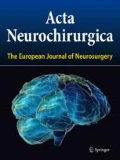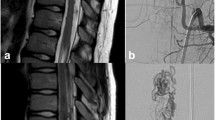Summary
Objective. To analyse possible relationships between the symptoms and signs created by intradural spinal cord arteriovenous shunts (SCAVSs) and their angio-architecture.
Methods. The clinical and radiological files of 155 patients, both adults and children, seen between 1981 and 1999 with a SCAVS were retrospectively reviewed. SCAVSs were divided into nidus type (small superficial or large intramedullary), and fistulas (micro (mAVFs)- or macrofistulas (MAVFs)). The angio-architectural points studied were arterial stenosis, proximal arterial aneurysm, distal arterial aneurysm, arteriovenous fistulas, pial venous drainage and/or reflux, venous ectasias, venous stenosis, venous thrombosis, false aneurysms. Correlations between architecture, location, age groups and symptoms and signs were made.
Findings. A male predominance was noted in both adults and children. Most of the lesions were located at the thoracic level, but hemorrhage occured as the presenting event predominantly in cervical localizations. 30 patients (20 AVMs; 4 mAVFs, 6 MAVFs) were children. 5 of the 6 MAVFs found in children were associated with Hereditary Hemorrhagic Telengiectasia (HHT1). Twenty one children (70%) had bled. Spontaneous total or subtotal recovery was the rule in 15 of those who had bled (72%) but early recurrent hemorrhages occured in 2. Among 125 adults 56 presented with hemorrhage (45%). The proportions of those who recovered spontaneously (71%) or rebled (3,6%) in the same year after the initial episode were very similar to children. All other adults presented with acute or progressive non-hemorrhagic episodes. There was no significant difference in the angio-architecture between hemorrhagic and non hemorrhagic SCAVS, except for that occurrence of pseudo-aneurysms. Hemorrhage in SCAVSs may not be exclusively due to haemodynamic factors. Venous congestion was responsible for progressive symptoms. Acute deficits unrelated to bleeds were due to intralesional thrombosis or hemodynamic changes.
Interpretation. The short term prognosis of hemorrhagic SCAVSs is good, and there is no need for emergency treatment. MRI delineates the cord and makes the diagnosis of the lesion but angiography remains the gold standard for analysis of the vasculature. The angio-architecture reflects the ageing of the lesion but there is not a precise correlation between angio-architecture and clinical symptoms, except for pseudoaneurysms which relate to the hemorrhagic portion of the lesion.
Similar content being viewed by others
Author information
Authors and Affiliations
Rights and permissions
About this article
Cite this article
Rodesch, G., Hurth, M., Alvarez, H. et al. Angio-architecture of spinal cord arteriovenous shunts at presentation. Clinical correlations in adults and children. Acta Neurochir 146, 217–227 (2004). https://doi.org/10.1007/s00701-003-0192-1
Published:
Issue Date:
DOI: https://doi.org/10.1007/s00701-003-0192-1




